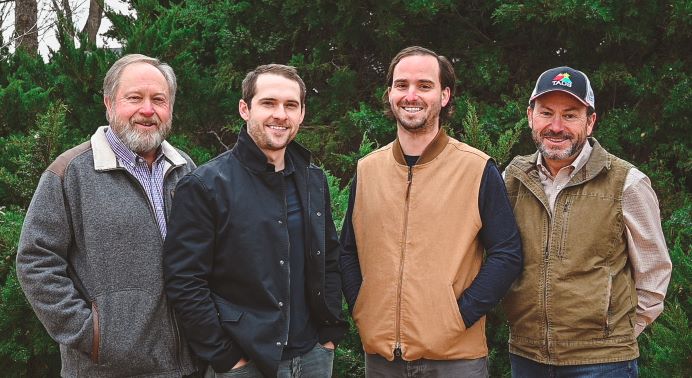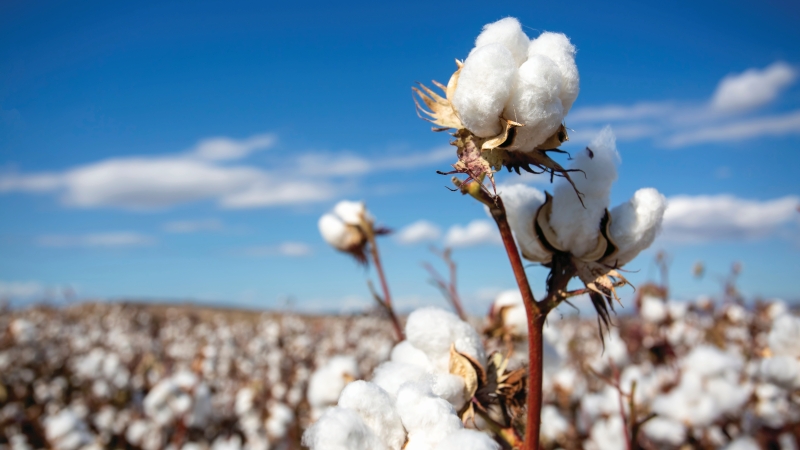Consistency Pays Off for 2021 Cotton Marketers of the Year
When Mark and Greg Howard got the word about winning the 2021 Joseph J. O’Neill Cotton Marketers of the Year award, they looked at each other and kind of wondered why.
“It’s always a little weird when you feel like you’ve done a questionable job and someone recognizes you for it,” says Mark, who manages the day-to-day marketing for H Bar H Farms in Dalhart, TX. “I don’t know if we were picked because of the price we achieved, because I’m pretty sure there are people who did a better job of attaining a high price. I think the people who nominated us liked our process and how we work at it, and that we’re consistent.”
Mark Howard (left) and his son Bryce with Greg Howard (right) and his son Brett
Truth is, that consistency is a big part of the success of H Bar H Farms – a family operation led by Mark and Greg, their sons Brett and Bryce, spouses, a number of cousins, and some close longtime friends. The farm settled on a half corn/half cotton rotation in the mid-‘90s and have stuck with it. It’s a large-acreage operation with two-thirds of those acres under irrigation.”
Greg, Brett, and Bryce primarily focus on production, allowing Mark to devote his attention to marketing. Whether it’s production or marketing, the farm’s main goal is to be stable and practice good, prudent risk management.
“We may not hit the top every year,” explains Mark. “We just want to avoid the bottoms and have a good stable place where we can operate at a profit and know next year what we’re going to be doing. If we’ve done our job right, our rotation will be the same every year because we have the equipment investment, the expertise in managing the rotation, and the marketing experience that allows us to maintain that.”
The operation has grown corn since the 1970s and added cotton following a trial-and-error search for a good rotation partner. Their location, however, doesn’t necessarily fit the description of prime cotton growing land. Higher elevations across their acres add a degree of difficulty to their cotton production.
“We started out with cotton at 4,300 feet elevation, then started in a neighboring county at 3,800 feet elevation,” recalls Mark. “There are easier places to grow cotton, but we’ve adapted to what we have. We also have a farm at 4,700 feet elevation, and we’re going to see what we can do with cotton there.”
The production challenges require innovation and a thorough understanding of what they can and can’t do with the crop. On their farm, cotton is always limited on time and heat units. And unlike most other Texas cotton areas where high micronaire is a concern, the Howards are more worried about low mic.
“We’re almost exactly the opposite of most cotton areas in this region,” says Mark. “We plant as early as we can in the spring. And another oddity about us is we plant on 15-inch rows and have done so since the mid-‘90s. We do it to capture all of the growing season we can. We feel it usually gives us a couple of weeks, especially in tough years like last year.
“The 15-inch row isn’t the easiest way to grow cotton, but it gives us decent results and we’ve stuck with it for a long time.”
Team Approach to Marketing
When it comes to marketing philosophy, Mark relies on multiple contacts, consultants, and sources for information. That team approach helps him balance and focus his marketing time based on what he knows is happening in the fields.
“The reason I can devote as much time as I do to marketing is I know the production end of it on the farm is being handled by my partners,” he says. “If you don’t have good, stable, assured production, it’s pretty hard to develop a marketing plan that works consistently year in and year out. We’re always worried about risk management. We’ve learned through the years that you can’t think price is never going to go past where you’ve established a floor, so you’d better have thoughts on how to manage both ends of it.
“We’re very concerned about production risk in our area,” he points out. “It wasn’t that long ago (2019) that we lost every acre. And that was following a banner year. Everything can fluctuate and is just very volatile. We try to tailor our marketing strategies around the production risk.”
More recently, higher cotton prices have allowed the Howards to establish floors where they can watch the market and look for places to buy it back and reestablish it.
“When we establish a floor, we want a floor that flexes with us so, if we lose the entire crop, we don’t end up with issues on that side of the game,” Mark says. “Marketing is a lot about relationships, and we’ve developed some very good ones through the gin and with different marketers, and through just trying to understand how to market cotton.
“It’s just about the hardest thing I’ve ever tried to sell,” he adds. “I’ve spent a lot of time trying to explain to cotton growers in our area what to look for and what it means. I’m barely able to understand it myself, so it makes for some odd conversations.”
When it comes to making marketing moves for the farm, Mark, Greg, and their sons all have skin in the game on decisions.
“We have daily discussions and I try to keep everybody informed,” notes Mark. “I’m not comfortable making decisions from the top down and prefer to get as many opinions from people I respect as I can before we make a major move. We all need to be on the same page and understand that if we make this commitment, we’re going to need to follow through with these moves and make sure we’re all working toward the same goal.
“I do get good questions,” he says, “and if I can’t explain the reasons why I think we should do something, then it probably doesn’t need to be done. I’m always bringing information to them and helping them to process it. But sometimes you make a move because it has to be done quickly. I trust them on the production, and they trust me on the marketing – we’re all working for the good of everyone. Sometimes it goes right. Sometimes you have a little problem. But together, we pretty much vet our strategies and things before we do them.”
Even after following their marketing model for years, Mark is quick to point out that intuition has little place in their plans.
“We trust our knowledge of what cotton is and does, but I can never find any trust level for the side of the business that’s not easily viewable by a farmer – things like the industry side of it, government policies, and the weather,” explains Mark. “We try to plan for one issue and find a good solid place to do some marketing. We try to scheme it all out the best we can so we have a direction in case this or that happens. The last four or five years have been pretty difficult to market anything. But we’re still here doing it and enjoying it.”
The Howards have their plan in place for 2022. They’ve set a good floor with lots of upside, but also know there’s a drought situation in West Texas and carryovers are fairly tight.
“We’ll make sure the upside is covered,” says Mark. “We like to market multiple years ahead if the opportunity is there, which is easier to do in some commodities than in others. Cotton can be fairly difficult. More than anything, we’re going to maintain our rotation, continue to practice risk management, and keep the upside open.”
That forward thinking also helps give the gin a step up on marketing because they know what their growers are going to be looking for and doing. And it’s one of the reasons behind the Howards’ recognition.
“You cannot find two better people who are proactively marketing their crop and are always willing to share the information they find with other producers,” says Craig Rohrbach of Parmer Cooperative Gin, who nominated the Howards.
Their bankers seem to like it, too.
The annual Marketer of the Year Award, presented by ICE Futures and BASF, honors the late Joe O’Neill, long-time President and CEO of the New York Cotton Exchange (now ICE Futures) and one of U.S. cotton’s greatest promoters.









